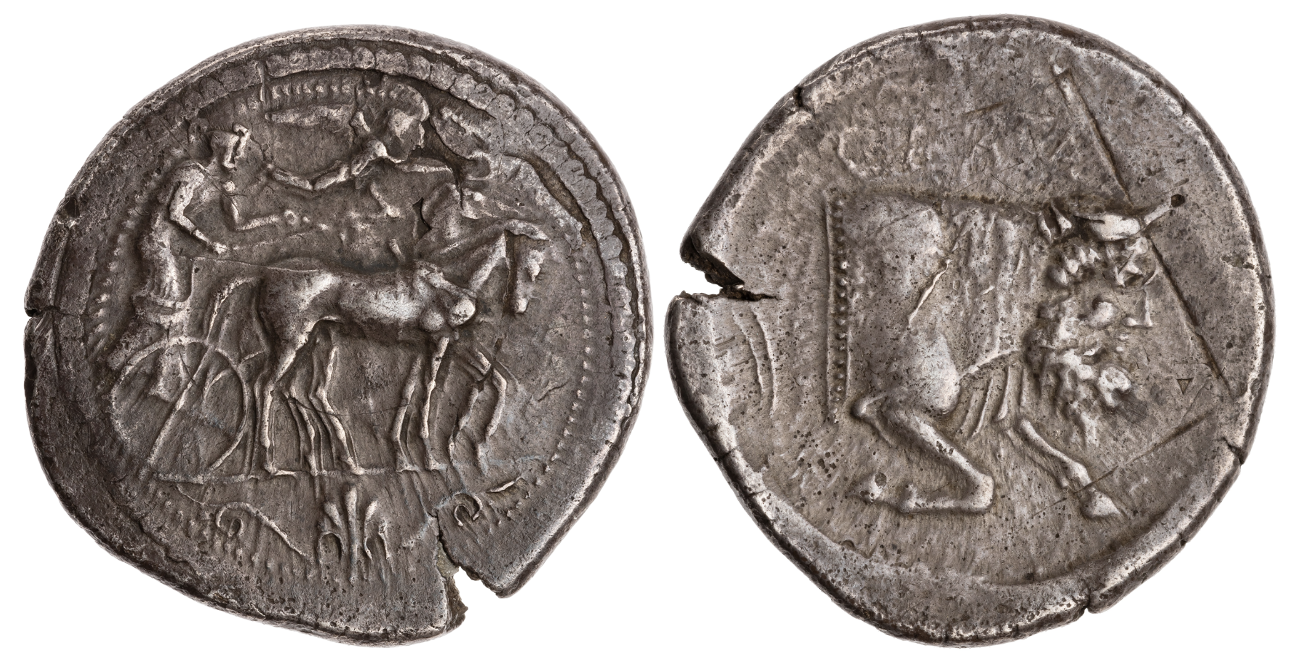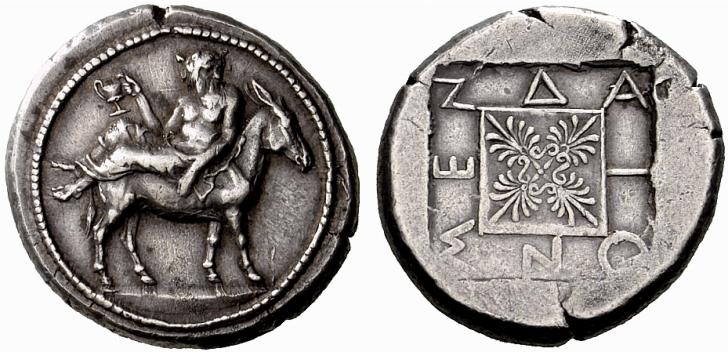450 BCE - 440 BCE | CELAΣ
Overstriking coin
SO_123_-_Gela_(tetradrachm).png
[1]
Overstruck variety
Mende_tetradrachm.jpg
[2]
Description
| ObverseInscription or printing placed on the obverse.:
|
Charioteer driving quadriga right, holding kentron and reins. Above, Nike flying right, crowning the horses with wreath. In exergue, palmette with tendrils. Border of dots.
|
ReverseInscription or printing placed on the reverse.:
|
CELAΣ (Greek) Forepart of man-headed bull (the river-god Gelas) right.
|
Mint and issuing power
| MintIdentifies the place of manufacture or issue of a numismatic object.:
|
Gela
|
Ancient regionAncient region.
|
Sicily
|
Modern countryModern country: Italy
|
AuthorityIdentifies the issuing power. The authority can be "pretended" when the name or the portrait of X is on the coin but he/she was not the issuing power. It can also be "uncertain" when there is no mention of X on the coin but he/she was the issuing power according to the historical sources:
|
|
Chronology
| FromIdentifies the initial date in a range assigned in a numismatic context. 450 BCE toIdentifies the final date in a range assigned in a numismatic context.. 440 BCE
|
Classical 480-323 BC  periodTime period of the numismatic object. periodTime period of the numismatic object.
|
Physical description
MetalThe physical material (usually metal) from which an object is made.: Silver 
|
WeightWeight of the numismatic object (in grams). in grams: 17.217.2 g <br />17,200 mg <br />
|
DenominationTerm indicating the value of a numismatic object. Examples: tetradrachm, chalkous, denarius.: tetradrachm 
|
AxisDescribes the directional relationship between the obverse and reverse of a numismatic object.: 1111 mm <br />1.1 cm <br />
|
|
|
StandardStandard.: Attic
|
References
| Coin referenceReference of the Coin:
|
Noe 1957, group IX, p. 37, (pl. XIII, e and XIV, e), SNG ANS 4 Sicily, n° 63
|
Coin series referenceReference to coin series study:
|
Jenkins 19701Jenkins 1970, group IV, 341-370., SNG ANS 4 Sicily2SNG ANS 4 Sicily, n° 63., HGC 23HGC 2, n° 343
|
| Coin series web referenceCoin series web references:
|
|
Description
| ObverseInscription or printing placed on the obverse.:
|
Dyonisus, head r., wearing ivy wreath and himation, reclining on mule back l., holding cantharus with r. hand and resting l. on the animal’s side
|
ReverseInscription or printing placed on the reverse.:
|
ΜΕΝ − ΔΑ − ΙΟ − Ν (Greek) Linear square containing four palmettes in saltire with a star in the centre, all within incuse square
|
Mint and issuing power
| MintIdentifies the place of manufacture or issue of a numismatic object. ᵖ:
|
Mende
|
Ancient regionAncient region. ᵖ
|
Macedon
|
Modern countryModern country: Greece
|
AuthorityIdentifies the authority in whose name (explicitly or implicitly) a numismatic object was issued. ᵖ:
|
|
Chronology
| FromIdentifies the initial date in a range assigned in a numismatic context. 460 BCE toIdentifies the final date in a range assigned in a numismatic context.. 423 BCE
|
Classical 480-323 BC  periodTime period of the numismatic object. periodTime period of the numismatic object.
|
Physical description
| DenominationTerm indicating the value of a numismatic object. Examples: tetradrachm, chalkous, denarius. ᵖ:
|
tetradrachm 
|
StandardStandard. ᵖ:
|
Attic
|
References
References
- ^ Jenkins, Gilbert Kenneth (1970), The Coinage of Gela, AMUGS II, 2 vol., Berlin
- ^ Sylloge Nummorum Graecorum ANS 4. The Collection of the American Numismatic Society. Sicily 2 (Galaria - Styella), New York, 1977, 25 pl.
- ^ Hoover, Oliver D. (2012), The Handbook of Greek Coinage Series. 2. Handbook of the Coins of Sicily (Including Lipara). Civic, Royal, Siculo-Punic, and Romano-Sicilian Issues. Sixth to First Centuries BC, Lancaster-London, 489 p.

